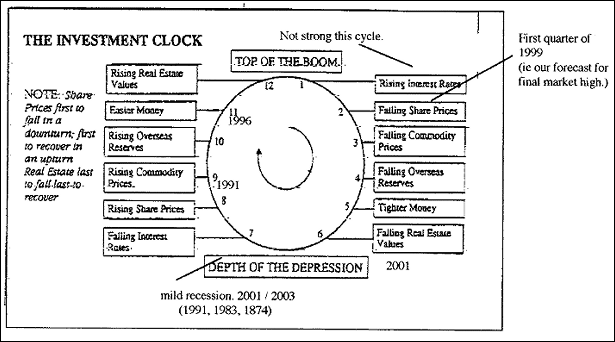The decade cycle.
Where are we ?
The previous recession has been officially dated as having ended in July 1991. (US March
1991) In the past, the decade cycle has run around 8 to 11 years, trough to trough (ie
recession to recession).
Measuring the worlds largest economy, the US, from cycle peak to trough, the following dates
can be ascertained:
peak trough.
April 1960 February 1961
December 1969 November 1970
November 1973 March 1975
January 1980 July 1980
July 1981 November 1982
July 1990 March 1991
Source: US National Bureau of Economic Research.
From the last US recession, March 1991, to the present time, say Feb 2000, will be 107 months
in duration. This compares to previous measured expansions (trough to peak) in the 1960's at
106 months, and in the 1980's of 92 months. You can see this current cycle expansion is in
the record books now.
The correlation of the US decade cycle, and Australia is quite close.
It is usual for each cycle to run in a similar sequence of events, but have its own defining
characteristics. This cycle has already been noted for its longer, slower and more
sustainable level of business activity. (As EIS suggested it would.) And with the much lower
levels of inflation, it is possible for business to maintain a longer term investment
outlook. Technological innovation flourishes in such conditions.
We put the cycle at around twelve o'clock, moving into one o'clock now. The decade cycle is
in top gear certainly. Given the nature of the entrepreneurial activity now taking place, and
the investment being undertaken by big business in the emerging technologies, it is difficult
to see a significant economic downturn taking place in the short term. Just note the order
that is next from one o'clock. Much will depend on the inflation level over coming months.
This is the figure to watch.

